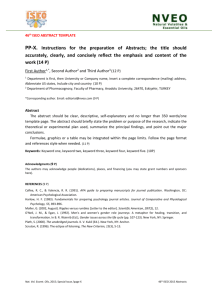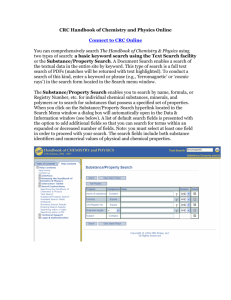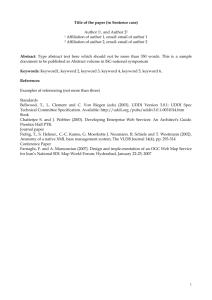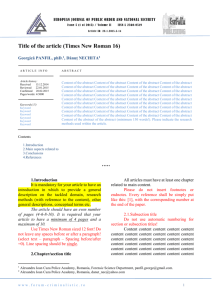Multilingual Approach to e-Learning from a Monolingual Perspective Vladislav Kubo ˇn
advertisement
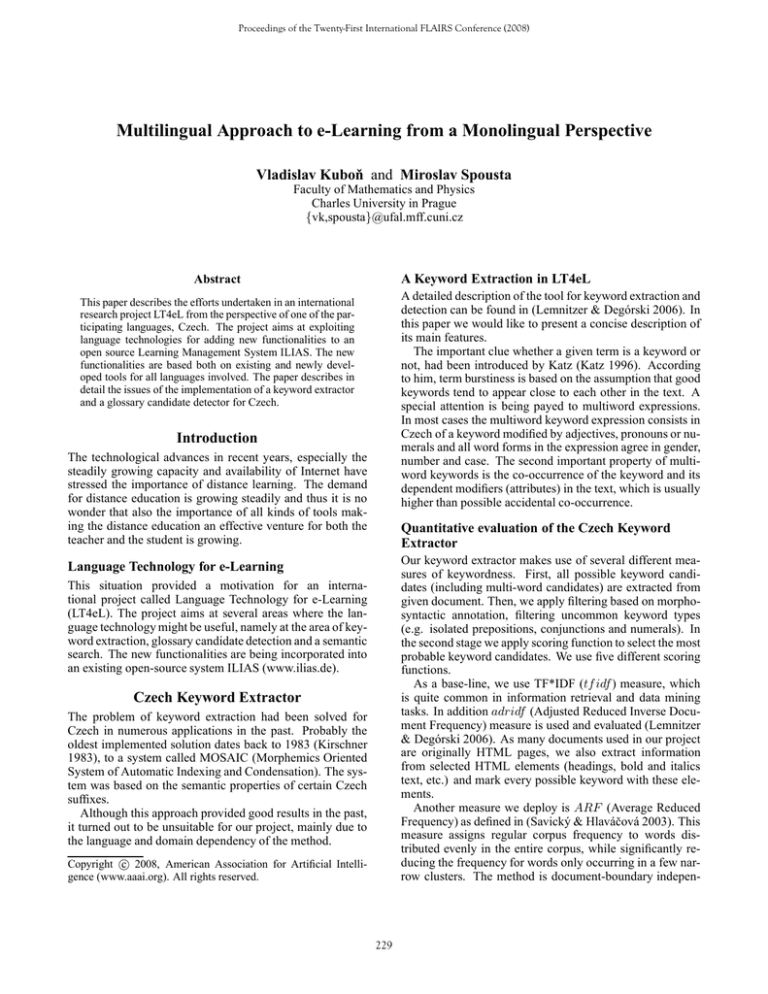
Proceedings of the Twenty-First International FLAIRS Conference (2008)
Multilingual Approach to e-Learning from a Monolingual Perspective
Vladislav Kuboň and Miroslav Spousta
Faculty of Mathematics and Physics
Charles University in Prague
{vk,spousta}@ufal.mff.cuni.cz
A Keyword Extraction in LT4eL
Abstract
A detailed description of the tool for keyword extraction and
detection can be found in (Lemnitzer & Degórski 2006). In
this paper we would like to present a concise description of
its main features.
The important clue whether a given term is a keyword or
not, had been introduced by Katz (Katz 1996). According
to him, term burstiness is based on the assumption that good
keywords tend to appear close to each other in the text. A
special attention is being payed to multiword expressions.
In most cases the multiword keyword expression consists in
Czech of a keyword modified by adjectives, pronouns or numerals and all word forms in the expression agree in gender,
number and case. The second important property of multiword keywords is the co-occurrence of the keyword and its
dependent modifiers (attributes) in the text, which is usually
higher than possible accidental co-occurrence.
This paper describes the efforts undertaken in an international
research project LT4eL from the perspective of one of the participating languages, Czech. The project aims at exploiting
language technologies for adding new functionalities to an
open source Learning Management System ILIAS. The new
functionalities are based both on existing and newly developed tools for all languages involved. The paper describes in
detail the issues of the implementation of a keyword extractor
and a glossary candidate detector for Czech.
Introduction
The technological advances in recent years, especially the
steadily growing capacity and availability of Internet have
stressed the importance of distance learning. The demand
for distance education is growing steadily and thus it is no
wonder that also the importance of all kinds of tools making the distance education an effective venture for both the
teacher and the student is growing.
Quantitative evaluation of the Czech Keyword
Extractor
Our keyword extractor makes use of several different measures of keywordness. First, all possible keyword candidates (including multi-word candidates) are extracted from
given document. Then, we apply filtering based on morphosyntactic annotation, filtering uncommon keyword types
(e.g. isolated prepositions, conjunctions and numerals). In
the second stage we apply scoring function to select the most
probable keyword candidates. We use five different scoring
functions.
As a base-line, we use TF*IDF (tf idf ) measure, which
is quite common in information retrieval and data mining
tasks. In addition adridf (Adjusted Reduced Inverse Document Frequency) measure is used and evaluated (Lemnitzer
& Degórski 2006). As many documents used in our project
are originally HTML pages, we also extract information
from selected HTML elements (headings, bold and italics
text, etc.) and mark every possible keyword with these elements.
Another measure we deploy is ARF (Average Reduced
Frequency) as defined in (Savický & Hlaváčová 2003). This
measure assigns regular corpus frequency to words distributed evenly in the entire corpus, while significantly reducing the frequency for words only occurring in a few narrow clusters. The method is document-boundary indepen-
Language Technology for e-Learning
This situation provided a motivation for an international project called Language Technology for e-Learning
(LT4eL). The project aims at several areas where the language technology might be useful, namely at the area of keyword extraction, glossary candidate detection and a semantic
search. The new functionalities are being incorporated into
an existing open-source system ILIAS (www.ilias.de).
Czech Keyword Extractor
The problem of keyword extraction had been solved for
Czech in numerous applications in the past. Probably the
oldest implemented solution dates back to 1983 (Kirschner
1983), to a system called MOSAIC (Morphemics Oriented
System of Automatic Indexing and Condensation). The system was based on the semantic properties of certain Czech
suffixes.
Although this approach provided good results in the past,
it turned out to be unsuitable for our project, mainly due to
the language and domain dependency of the method.
c 2008, American Association for Artificial IntelliCopyright gence (www.aaai.org). All rights reserved.
229
Pattern
NP is/are NP
NP verb NP
structural
NP (NP)
NP /:/= NP
other patterns
dent and thus it is not biased by uneven document size. For
ranking keywords, we divide regular corpus term frequency
by ARF and multiply the result by a term frequency.
We have also tried to combine all these methods using a
linear combination computed by the Expectation Maximization algorithm.
Most methods for keyword extraction are directly dependent on the size of corpus used for extraction of background
frequency information. Our corpus consists of 46 documents
of variable size (1799 – 139 829 tokens), with total size exceeding 1 million tokens. For the purposes of evaluation we
manually annotated 18 randomly selected documents. These
documents were split into two parts: training (9 documents)
and evaluation (9 documents).
In our tests we used methodology described in (Lemnitzer
& Degórski 2006), we set up a threshold for all automatic
keyword extraction method to 150% of number of manually
selected keywords. Results for F2 measure average across
all test documents are shown in Table 1.
Method
F2
tfidf
26.21
adridf
25.62
Layout
24.31
ARF
26.84
Occurrences in the corpus
52
45
39
30
20
59
Table 2: Czech definition types
measure is 28.9). But the tests of an inter-annotator agreement had shown that not even the human annotators are sure
about the definitions either, so the automatic tool generally
performs not much worse than the humans.
The second reason why the detection of definitory contexts scored so low for Czech concerns the typological properties of the language. It has a very rich flection and a relatively very free word order, both properties which are extremely difficult to capture by a simple grammar presented
above.
Combined
28.28
Conclusions
Table 1: Keyword extractor results (F2 measure)
This paper concentrates on the issues encountered during the
implementation of language technology tools for one language contained in the international project Language Technology for e–Learning, Czech. The typological properties of
Czech enabled to view the problems of language technology
tools from the perspective of languages which pose a challenge to many widely accepted natural language processing
tools and methods due to the richness of their inflection and
the high degree of word-order freedom.
In the future we would like to test some alternative methods for both the keyword extractor and glossary candidate
detector. These experiments might answer the crucial question whether by making the language technology tools more
language dependent it would be possible to obtain substantially better results for the tasks performed in the project.
Unfortunately, the results are more affected by the nature
of documents they were tested upon, they differ much more
across documents than they do across individual types of input data, therefore it is impossible to make at the moment
any reliable judgment which setup is best. The factor which
definitely plays a role is the length of the input document.
Czech Glossary Candidate Detector
The main task of the glossary candidate detection is to find
definitory contexts of keywords retrieved by the keyword extractor. The input text has technically a form of an XML text
with morphological tags. This input is being processed by
simple regular grammars which are different for each language. The grammars are implemented by means of a tool
called lxtransduce (cf. (Tobin 2005)). This tool belongs to
the LTXML2 set of tools developed at the University of Edinburgh.
The Czech training corpus used for GCD has 231 115 tokens in 7 documents on various topics and 1069 hand annotated definitions. The testing corpus consists of 12 smaller
documents with 90 571 tokens and 174 hand annotated definitions. Out of the 174 hand annotated definitions 153 are
contained in a single sentence, 6 span 2 sentences, and 3
definitions span 3 sentences.
The Czech grammar uses 21 grammar rules at the highest level, divided into 5 groups. The most successful rules
belong to the category NP je/jsou NP - [NP is/are NP]. Relatively successful are also the rules exploiting certain specific
verbs - definovat - [define], znamenat - [mean], vymezovat
- [define], představovat - [constitute] etc. Table 2 contains
the statistics concerning individual types of Czech grammar
rules.
The precision and recall of the above mentioned grammar is relatively low: 18.3% and 40.7%, respectively (F2
References
Katz, S. M. 1996. Distribution of content words and
phrases in text and language modelling. Nat. Lang. Eng.
2(1):15–59.
Kirschner, Z. 1983. MOSAIC – A Method of Automatic
Extraction of Significant Terms from Texts. Prague: MFF
UK.
Lemnitzer, L., and Degórski, L. 2006. Language technology for elearning – implementing a keyword extractor. Paper presented at the fourth EDEN Research Workshop Research into online distance education and eLearning. Making the Difference, 2006 in Castelldefels, Spain.
Savický, P., and Hlaváčová, J. 2003. Measures of
Word Commonness. Journal of Quantitative Linguistics
9(3):215—231.
Tobin, R. 2005. Lxtransduce, a replacement for fsgmatch.
http://www.ltg.ed.ac.uk/richard/ltxml2/lxtransducemanual.html.
230

